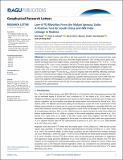Files in this item
Low-δ18O rhyolites from the Malani Igneous Suite : a positive test for South China and NW India linkage in Rodinia
Item metadata
| dc.contributor.author | Wang, Wei | |
| dc.contributor.author | Cawood, Peter A. | |
| dc.contributor.author | Zhou, Mei-Fu | |
| dc.contributor.author | Pandit, Manoj K. | |
| dc.contributor.author | Xia, Xiao-Ping | |
| dc.contributor.author | Zhao, Jun-Hong | |
| dc.date.accessioned | 2018-04-30T23:33:10Z | |
| dc.date.available | 2018-04-30T23:33:10Z | |
| dc.date.issued | 2017-10-30 | |
| dc.identifier | 251328910 | |
| dc.identifier | 8c5fa25f-598b-41e6-9899-0b055a9515eb | |
| dc.identifier | 85034089529 | |
| dc.identifier | 000416761600026 | |
| dc.identifier.citation | Wang , W , Cawood , P A , Zhou , M-F , Pandit , M K , Xia , X-P & Zhao , J-H 2017 , ' Low-δ 18 O rhyolites from the Malani Igneous Suite : a positive test for South China and NW India linkage in Rodinia ' , Geophysical Research Letters , vol. 44 , no. 20 , pp. 10298-10305 . https://doi.org/10.1002/2017GL074717 | en |
| dc.identifier.issn | 1944-8007 | |
| dc.identifier.other | Bibtex: urn:35614874e4d2dd43fad07cac58cd05f5 | |
| dc.identifier.uri | https://hdl.handle.net/10023/13266 | |
| dc.description | This study was supported by the National Natural Science Foundation of China (NSFC41572170), “Thousand Youth Talents Plan” grant to Wei Wang, Guangzhou municipal government (201607020029), and MOST Special Fund from the State Key Laboratory of Geological Processes and Mineral Resources (MSFGPMR11 and 01-1). P.A.C. acknowledges support from Australian Research Council grant FL160100168. | en |
| dc.description.abstract | The Malani Igneous Suite (MIS) in NW India represents one of the best preserved silicic large igneous provinces. Voluminous silicic lavas of the MIS erupted between ca. 780-750 Ma. Zircon grains from rhyolite and dacite lavas have oxygen isotopic compositions that include depleted (δ18O = 4.12 to -1.11‰) and enriched (δ18O = 8.23-5.12‰) signatures. The low-δ18O zircon grains have highly radiogenic Hf isotopic compositions (ƐHf(t)= +13.0 to +3.6), suggesting high temperature bulk cannibalization of upper level juvenile mafic crust as an essential mechanism to produce the low-δ18O felsic magma. Xenocrystic zircon grains in dacites have high δ18O and low ƐHf(t) values for magmas older than 800 Ma, reflecting a dramatic transition in tectono-thermal regime in NW India during 800-780 Ma. A synchronous transition also occurred in South China and Madagascar, suggesting a spatially linked geodynamic system. NW India and South China together with Madagascar and the Seychelles lay either along the periphery of Rodinia or outboards of the supercontinent with the age of convergent plate margin magmatism coinciding with breakup of the supercontinent. | |
| dc.format.extent | 2071919 | |
| dc.language.iso | eng | |
| dc.relation.ispartof | Geophysical Research Letters | en |
| dc.subject | Low δ18O magma | en |
| dc.subject | Malani Igneous Suite | en |
| dc.subject | Localized lithospheric extension | en |
| dc.subject | NW India | en |
| dc.subject | South China | en |
| dc.subject | Rodinia | en |
| dc.subject | QE Geology | en |
| dc.subject | DAS | en |
| dc.subject.lcc | QE | en |
| dc.title | Low-δ18O rhyolites from the Malani Igneous Suite : a positive test for South China and NW India linkage in Rodinia | en |
| dc.type | Journal article | en |
| dc.contributor.institution | University of St Andrews. School of Earth & Environmental Sciences | en |
| dc.contributor.institution | University of St Andrews. Scottish Oceans Institute | en |
| dc.contributor.institution | University of St Andrews. St Andrews Isotope Geochemistry | en |
| dc.identifier.doi | https://doi.org/10.1002/2017GL074717 | |
| dc.description.status | Peer reviewed | en |
| dc.date.embargoedUntil | 2018-04-30 |
This item appears in the following Collection(s)
Items in the St Andrews Research Repository are protected by copyright, with all rights reserved, unless otherwise indicated.

